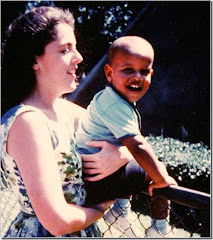CIVIL UNIONS, MARRIAGE AND THE BIBLE
I've got this whole thing figured out.
What we need to do is offer separate Civil Unions and Marriages to everyone, gay or straight, with the following definitions:
CIVIL UNION: A legally recognized partnership between 2 citizens which entitles each to all of the legally recognized benefits that we currently associate with marriage. It would have to be recognized by all 50 states under the Constitutional mandate of equal protection under the law.
MARRIAGE: A divinely sanctioned union of two people granted and recognized by a religious institution
A couple may choose to have a Civil Union without a Marriage, or a Marriage without a Civil Union, or they can have both. Civil Unions would be administered by the State. Marriages by a church.
If a gay couple wanted a Civil Union, they could have one. If they wanted a Marriage and could find a church willing to sanction it, they could have one. After all, if gay people want to get "married", who cares? They should have the same right to be nagged, ignored, taken for granted, lied to, cheated on and driven into bankruptcy as anyone else. God bless 'em. Go for it. They'd be about the ONLY marriages where there was a high likelyhood of anal and oral sex taking place, so they've got that workin' for 'em.
QUESTION: Know what the difference is between a wife and a job?
ANSWER: After a few years, the job still sucks.
I get really pissed off when I hear people say "The Bible says that a marriage is between one man and one woman". Ahem (getting ready for this) BULLSHIT! Sayin' it don't make it so, Sparky.
With proper credit to religioustolerance.org, here are some examples of how "The Bible" deals with the subject of marriage. Do we REALLY want to follow these examples?
**************************************
Family types mentioned in the Bible:
1. The standard nuclear family: Genesis 2:24 describes how a man leaves his family of origin, joins with a woman, consummates the marriage and lives as a couple. There were quite a few differences between the customs and laws of contemporary North Americans and of ancient Israelites. In ancient Israel: Inter-faith marriages were theoretically forbidden. However, they were sometimes formed.
Children of inter-faith marriages were considered illegitimate.
Marriages were generally arranged by family or friends; they did not result from a gradually evolving, loving relationship that developed during a period of courtship.
A bride who had been presented as a virgin and who could not be proven to be one was stoned to death by the men of her village. (Deuteronomy 22:13-21) There appears to have been no similar penalty for men who engaged in consensual pre-marital sexual activity.
2. Polygyny marriage: A man would leave his family of origin and join with his first wife. Then, as finances allowed, he would marry as many additional women as he desired. The new wives would join the man and his other wives in an already established household. Polygyny was practiced by members of the Church of Jesus Christ of Latter-day Saints, the Mormons, until the practice was suspended, a least temporarily, in the late 19th century. It is still practiced by separated fundamentalist Mormon groups which have been excommunicated from the main church.
There are many references to polygynous marriages in the Bible: Lamech, in Genesis 4:19, became the first known polygynist. He had two wives.
Subsequent men in polygynous relationships included: Esau with 3 wives;
Jacob: 2;
Ashur: 2;
Gideon: many;
Elkanah: 2;
David: many;
Solomon had 700 wives of royal birth;
Rehaboam: 3;
Abijah: 14.
Jehoram, Joash, Ahab, Jeholachin and Belshazzar also had multiple wives.
From the historical record, it is known that Herod the Great (73 to 4 BCE) had nine wives.
We have been unable to find references to polyandrous marriages in the Bible -- unions involving one woman and more than one man. It is unlikely that many existed because of the distinctly inferior status given to women; they were often treated as property in the Hebrew Scriptures.
3. Levirate Marriage: The name of this type of marriage is derived from the Latin word "levir," which means "brother-in-law." This involved a woman who was widowed without having borne a son. She would be required to leave her home, marry her brother-in-law, live with him, and engage in sexual relations. If there were feelings of attraction and love between the woman and her new husband, this arrangement could be quite agreeable to both. Otherwise, the woman would have to endure what was essentially serial rapes with her former brother-in-law as perpetrator. Their first-born son was considered to be sired by the deceased husband. In Genesis 38:6-10, Tamar's husband Er was killed by God for unspecified sinful behavior. Er's brother, Onan, was then required by custom to marry Tamar. Not wanting to have a child who would not be considered his, he engaged in an elementary (and quite unreliable) method of birth control: coitus interruptus. God appears to have given a very high priority to the levirate marriage obligation. Being very displeased with Onan's behavior, God killed him as well. Ruth 4 reveals that a man would be required to enter into a levirate marriage not only with his late brother's widow, but with a widow to whom he was the closest living relative.
4. A man, a woman and her property -- a female slave: As described in Genesis 16, Sarah and Abram were infertile. Sarah owned Hagar, a female slave who apparently had been purchased earlier in Egypt. Because Hagar was Sarah's property, she could dispose of her as she wished. Sarah gave Hagar to Abram as a type of wife, so that Abram would have an heir. Presumably, the arrangement to marry and engage in sexual activity was done without the consent of Hagar, who had such a low status in the society of the day that she was required to submit to what she probably felt were serial rapes by Abram. Hagar conceived and bore a son, Ishmael. This type of marriage had some points of similarity to polygamous marriage, as described above. However, Hagar's status as a human slave in a plural marriage with two free individuals makes it sufficiently different to warrant separate treatment here.
[Editors Note: So the founder of Judaism, Christianity AND Islam had a sort of forced Menage a Tois?]
5. A man, one or more wives, and some concubines: A man could keep numerous concubines, in addition to one or more wives. These women held an even lower status than a wife. As implied in Genesis 21:10, a concubine could be dismissed when no longer wanted. According to Smith's Bible Dictionary, "A concubine would generally be either (1) a Hebrew girl bought...[from] her father; (2) a Gentile captive taken in war; (3) a foreign slave bought; or (4) a Canaanitish woman, bond or free." 1 They would probably be brought into an already-established household. Abraham had two concubines; Gideon: at least 1; Nahor: 1; Jacob: 1; Eliphaz: 1; Gideon: 1; Caleb: 2; Manassah: 1; Saul: 1; David: at least 10; Rehoboam: 60; Solomon: 300!; an unidentified Levite: 1; Belshazzar: more than 1.
6. A male soldier and a female prisoner of war: Numbers 31:1-18 describes how the army of the ancient Israelites killed every adult Midianite male in battle. Moses then ordered the slaughter in cold blood of most of the captives, including all of the male children who numbered about 32,000. Only the lives of 32,000 women - all virgins -- were spared. Some of the latter were given to the priests as slaves. Most were taken by the Israeli soldiers as captives of war. Deuteronomy 21:11-14 describes how each captive woman would shave her head, pare her nails, be left alone to mourn the loss of her families, friends, and freedom. After a full month had passed, they would be required to submit to their owners sexually, as a wife. It is conceivable that in a few cases, a love bond might have formed between the soldier and his captive(s). However, in most cases we can assume that the woman had to submit sexually against her will; that is, she was raped.
7. A male rapist and his victim: Deuteronomy 22:28-29 requires that a female virgin who is not engaged to be married and who has been raped must marry her attacker, no matter what her feelings were towards the rapist. A man could become married by simply sexually attacking a woman that appealed to him, and paying his father-in-law 50 shekels of silver. There is one disadvantage of this approach: he was not allowed to subsequently divorce her.
8. A male and female slave: Exodus 21:4 indicates that a slave owner could assign one of his female slaves to one of his male slaves as a wife. There is no indication that women were consulted during this type of transaction. The arrangement would probably involve rape in most cases. In the times of the Hebrew Scriptures, Israelite women who were sold into slavery by their fathers were slaves forever. Men, and women who became slaves by another route, were limited to serving as slaves for seven years. When a male slave left his owner, the marriage would normally be terminated; his wife would stay behind, with any children that she had. He could elect to stay a slave if he wished.
***********************************************
So, by all means, let's let The Infallible Word Of God, The Holy Bible, dictate to us how we define marriage.
































No comments:
Post a Comment